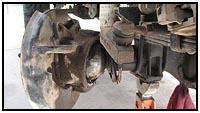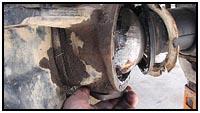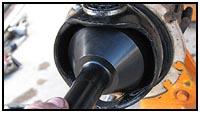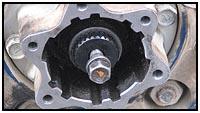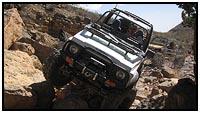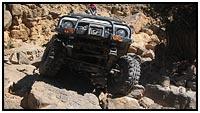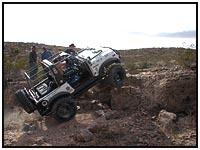 with Bill Johnston
with Bill Johnston
26 Spline RCV Performance Axlesfrom Spidertrax
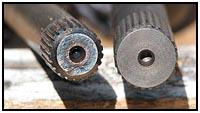 Have you ever looked closely at the front axle shafts in a Samurai? Have you ever wanted to upgrade without major component replacement? The front axles meet the differentials using a small 22 spline pattern. The rear axles slide into the same kind of differential using a stronger 26 spline pattern. So Suzuki already makes the hard part, we just need something up front that can use the stronger sidegears. Here is a cut from our first article last year when Spidertrax provided a prototype set of their new axle shafts for the Raffle at ZookiMelt 2007.
Have you ever looked closely at the front axle shafts in a Samurai? Have you ever wanted to upgrade without major component replacement? The front axles meet the differentials using a small 22 spline pattern. The rear axles slide into the same kind of differential using a stronger 26 spline pattern. So Suzuki already makes the hard part, we just need something up front that can use the stronger sidegears. Here is a cut from our first article last year when Spidertrax provided a prototype set of their new axle shafts for the Raffle at ZookiMelt 2007.
The Samurai 26 Spline Chromoly Axle Shafts have a fun history which I am happy to share. We got involved in this project early on when companies started selling what seemed to be the same product, a chromoly 26 spline upgraded axle shaft. Rightfully so, both of their products came from the same original source. The company responsible for the original design and manufacturing, Illinois based Rockford, are the same east coast guys that are responsible for other highly known upgraded CV axle products (Toyota and Dana 60 applications come to mind). They are good guys and do some really nice work, especially when you consider the degree of difficulty in manufacturing the components for the CV/Birfield itself.
So, what does all this mean? Early on, for whatever reason, a wrong material selection for the inner 26 spline axle shafts caused unwarranted failures. Although under warranty, it still leaves a bad taste in your mouth when you pay almost $600 for something that seems to fail just like OEM. We were not selling the product at that time, but were quickly contacted by dozens of guys looking for a better solution. Since we were already making our own, and highly successful, full floater shafts for the Spider 9 competitors, we were in a position to create a solution.
In all fairness, Rockford is a specialty CV design and manufacturing company and not Suzuki specialists. So, we went ahead and redesigned the inner 26 spline axle shafts with not only better material (4340 with heat treat after machining), but also a better shape to allow for more flex and proper oil sealing. What the winner at the raffle got was our version of what this product should have been from day one. It uses the Rockford CV/Birfield stub assembly coupled with our own chromoly 26 spline inner axle shafts.
We have yet to officially release this product because we are working hard in getting the retail price down to $499 for an entire front set. We think this is completely achievable and hope to have these rolling, at that price, by the end of the year.
Tom Kingston, Spidertrax Off-Road
Since Tom wrote this, he has been true to his word as they are now available for the price goal they originally set. They are not very difficult to install, so let’s get to it!
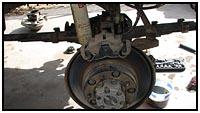
 After putting the front axle up on jack stands for safety, the tires came off. The caps came off easily from the locking hubs and the ‘C’ clip was removed from the end of the outer axle stub.
After putting the front axle up on jack stands for safety, the tires came off. The caps came off easily from the locking hubs and the ‘C’ clip was removed from the end of the outer axle stub. 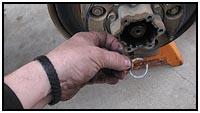
 This ‘C’ clip will fit onto the new stub shaft, so keep it handy. Next, to make it easy, remove the tie rod. This rig is outfitted with one of the original ‘high steer’ conversions, so the additional arm in the picture to the right attaches to the drag link.
This ‘C’ clip will fit onto the new stub shaft, so keep it handy. Next, to make it easy, remove the tie rod. This rig is outfitted with one of the original ‘high steer’ conversions, so the additional arm in the picture to the right attaches to the drag link. 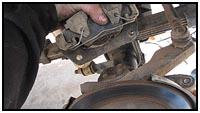
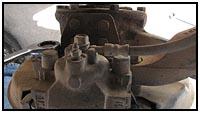 Next comes the brake caliper. Remove it and push it out of the way.
Next comes the brake caliper. Remove it and push it out of the way. 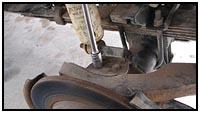
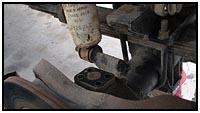 The kingpins (top and bottom) are next. Pull the bolts but leave the kingpins in place until you are ready to remove the knuckle. Again you can see the high steer bracket, but ignore it if you still have stock steering.
The kingpins (top and bottom) are next. Pull the bolts but leave the kingpins in place until you are ready to remove the knuckle. Again you can see the high steer bracket, but ignore it if you still have stock steering.
When removing the seal retainers that hold in the felts and rubber gasket, be careful not to damage them. Otherwise you might want to think about replacing them with new components… remember this is a twenty year old vehicle.
Once the seals are released, the knuckle is ready to be removed from the axle housing. The kingpins are removed while the knuckle is supported and pulled from the housing letting the outer stub slide out. Then the stub shaft/birfield and inner shaft are pulled from the housing. Do it gently and you may not have to replace the seal inside the end of the housing. 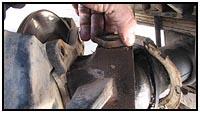
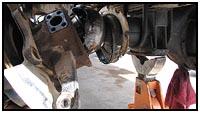
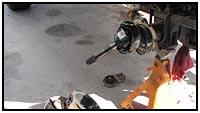
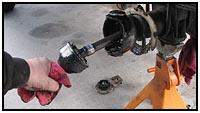

 If you find a bunch of sludge in the knuckle, you should consider new seals as this is from the gear oil in the housing leaking into the grease in the knuckle and making an oily mud mixture that doesn’t do anyone any good.
If you find a bunch of sludge in the knuckle, you should consider new seals as this is from the gear oil in the housing leaking into the grease in the knuckle and making an oily mud mixture that doesn’t do anyone any good.
After removing the knuckles from both sides, it is time to remove the differential from the axle housing.
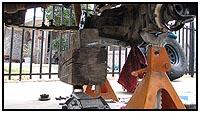
 Sometimes removing the differential can be a very sticky, stubborn problem. You can break the seal if you use a floor jack to force the front of the differential up until the seal gives way. Be careful you don’t lift the axle housing off of the jack stands or you could have a problem as the vehicle could slide off and hurt you badly.
Sometimes removing the differential can be a very sticky, stubborn problem. You can break the seal if you use a floor jack to force the front of the differential up until the seal gives way. Be careful you don’t lift the axle housing off of the jack stands or you could have a problem as the vehicle could slide off and hurt you badly.

 Time to prepare the differential with sidegears to fit the larger shafts.
Time to prepare the differential with sidegears to fit the larger shafts.
To see aStock Sidegear Swap(Click here)
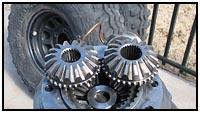
 And if you are running ARB’s, you will need to order the correct sidegears from them.
And if you are running ARB’s, you will need to order the correct sidegears from them.
To see anARB Sidegear Swap(Click here)

 Once the sidegears have been swapped out in the differential we can start looking at the new shafts. Just looking at the side by side comparison should show you that they are beefy. The stock components look like toys (and I don’t mean Toyota’s!).
Once the sidegears have been swapped out in the differential we can start looking at the new shafts. Just looking at the side by side comparison should show you that they are beefy. The stock components look like toys (and I don’t mean Toyota’s!). 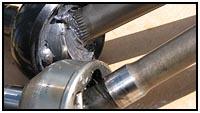
 You can see how the factory components ‘neck down’ to the size required to fit the smaller 22 spline opening. You can also see how the surface is built up to meet the sealing surface. The new axle shafts just start big and stay big – all the way across.
You can see how the factory components ‘neck down’ to the size required to fit the smaller 22 spline opening. You can also see how the surface is built up to meet the sealing surface. The new axle shafts just start big and stay big – all the way across. 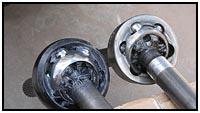
 The birfield is also a new unit. Designed stronger and larger than stock, it still has the same articulation capability.
The birfield is also a new unit. Designed stronger and larger than stock, it still has the same articulation capability. 
 The stub shaft is also a stronger design. After seeing the black finish, we call it the ‘Darth Vader’ of birfields!
The stub shaft is also a stronger design. After seeing the black finish, we call it the ‘Darth Vader’ of birfields!
Although the new birfield design seems to be a very tight fit, it will still fit with no additional clearancing of the inner knuckle. They were also thoughtful enough to retain the factory tapped hole at the end that you can use to pull the stub out far enough to install that ‘C’ clip we saw up at the top of the article. You can use a kingpin bolt as a handle.
My first trip out for testing was to explore the trails north of Las Cruces, New Mexico during the 2008 Chile Challenge. I have broken many front axle shafts in these canyons, but this trip I found that any concerns I had before were gone. I could wheel the lines I wanted without worrying about putting too much stress on the equipment when the wheels were turned. Great going Spidertrax!
Spidertrax Inc. 7510 Hygiene Road Longmont, CO 80503
Phone (800) 286-0898 (303) 772-0033
Fax (720) 294-9950
08/11/10 15:09:01

